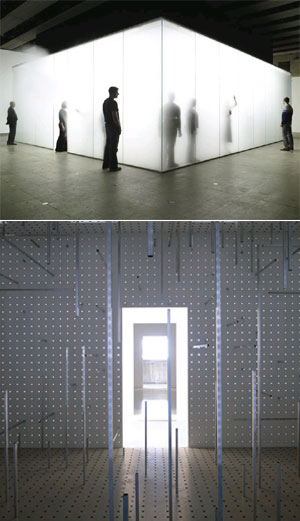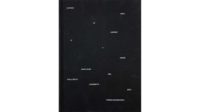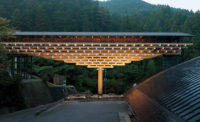After landing at the dock and walking through the parklike serenity of this walled island, you finally catch a view of the cinema, a pavilion with the same oval rondeur, says the artist, as the great Fenice Theater. Though it functions as a theater showing documentary films and holds an audience of 35 to 40 on its stepped rows of square seats, the pavilion retains a special intimacy and scale that make viewers feel they are entering an architectural model itself. On the outside, Putrih assembled a seemingly random (though actually precise) criss-cross installation of rusted trusswork bolted into place. Inside, he hung a white canvas curtain that darkens the interior and designed an inner wall with plywood baffles cut into wiggling, biomorphically shaped slats that recall the Paradise’s decorative forms.

During the biennale, the pavilion served as a venue for documentary films. But the main event was between shows, as it once must have seemed to children at the Paradise Theater. The canvas curtain is drawn back, and slowly, the undulating plywood slats are brought alive by flames of gold, then red light, like a spectacular sunrise. The theater becomes a place apart from its surroundings, a regal folly in the garden. And just before the colored lights subside, the pavilion’s shallow-domed ceiling grabs your attention with projected clouds that gradually dim into a starry night. Leaving Venetian, Atmospheric at night is like leaving one of those lively, brightly lit Venetian campi filled with joyous crowds and heading out into the dark, narrow, and quiet streets.
Meanwhile in London British artist Antony Gormley’s succession of cast-iron and fiberglass sculptures molded from his own body would appear to be a self-absorbed art, but his recent exhibition at the Hayward links his particular image to the more universal theme of individual alienation within architectural surroundings. As he writes in the exhibition guide, “I think that architecture is another kind of body, another container.” You can see the ideas behind his architectural sculptures in a haunting series of photographs that he took between 1979 and 2007. Entitled Quads (as they’re grouped in fours), these images meld shades of blue with an occasional gleam of golden light. In one group, for example, figures walking on the crest of a mountain emerge from the early morning fog; a deserted power plant stands in the light of dawn; a lone cable car drifts across a dark, misty sky; and a single man waits on a brightly lit subway platform among a forest of columns. The message is one of isolation.
Human figures abound in this exhibition, from heavy cast iron to dematerialized wire mesh, and sometimes take the measure of space in the fashion of Leonardo de Vinci’s Man of Perfect Proportions—in one work by bending at right angles in the corners of a room. But Gormley also asks viewers to take their own measure by confronting complete isolation in his Blind Light installation. Anyone who has driven at night in thick fog knows what it feels like to enter this freestanding glass room filled with a dense cloud made more intense by white neon light. It takes courage to step inside, but I did. I thought immediately of Gormley’s photograph of a man standing in fogbound woods not knowing which way to turn. I stood stock still, totally disoriented, and then, like everyone else, I gingerly sought an exterior wall to feel my way around. Once outside again, I watched the disembodied hands and arms of the people inside searching for solidity and thought this is what Gormley must experience when seeing visitors bring his sculptures to life and to terms with consciousness.
In an installation titled Allotment II, the artist proved his point that the “body is our first habitation, the building our second.” Here he built a miniature city of vertical structures, each based on the measurements and features of some 300 inhabitants of the Swedish city of Malmö, adults and children. What first looked like hulking reinforced-concrete structures on a grid of streets suddenly appeared more human as their differences revealed themselves. (A good lesson there.) In another piece, Hatch, Gormley deals more directly with perception by enticing the viewer into a room of white plywood and Plexiglas lined with peg-boardlike walls of square apertures. Inside, long and short rectangular aluminum rods spike out in every direction from the walls and floor (dangerous for more than two people at once). While most people in the room looked through the rods to see kaleidoscopic images of pixelated cubes, I enjoyed looking through the square holes from the outside to see ever-increasing circles of light.
Figures against the sky Not satisfied with occupying just the interior galleries with his work, Gormley used the Hayward’s three outside terraces as a viewing platform for his largest architectural installation, Event Horizon: 27 life-size casts of the artist mounted on buildings around the Hayward on the South Bank and on the horizon across the Thames far in the distance. You begin counting the cast figures nearby and then squint into the “expanding universe,” a cosmological phenomenon from which he takes his title. But suddenly, there it is, all of London, appearing almost in miniature from a distance, with Gormley’s figures merely pencil-thin lines against the sky, sculpture inhabiting architecture in an atmospheric theater in the round.
By constructing impermanent, illusionary, and fictional worlds with architecture, both Putrih and Gormley enlist the participation of viewers to complete their art. What remains is the memory and the perceptions gained through these experiences of imagination rather than function.





Post a comment to this article
Report Abusive Comment